A Methodology of Policy Assessment at the Municipal Level: Costa Rica´s Readiness for the Implementation of Nature-Based-Solutions for Urban Stormwater Management
Abstract
1. Introduction
2. Background and Methodology
2.1. Nature-Based-Solutions for Urban Sustainability Policies
2.2. Urban Experiments for Urban Sustainability Policies
2.2.1. The NYC Green Infrastructure Plan as a Guiding Urban Experiment for Urban Sustainability Policies
2.2.2. A Future Urban Experiment Setting on NBS in the Llorente district, Municipality of Flores, Costa Rica
2.3. Methodology
2.3.1. Proposed Methodological Tool to Endorse Sustainability Policies Related to NBS and Its Replication
2.3.2. Proposed Methodological Tool to Assess the Municipal Policy Readiness in the Implementation of NBS
2.3.3. Data Collection
3. Results
Policy Readiness Assessment of the Municipality of Flores in the Implementation of NBS
4. Discussion
5. Conclusions
Author Contributions
Funding
Acknowledgments
Conflicts of Interest
Appendix A
| Organic Law of the Environment (No.7554) |
|
| Law of Biodiversity (No. 7788) |
|
| Water Law (No.276) |
|
| Forest Law (No. 7575) |
|
| Law of Health (No. 5395) |
|
| The Penal Code |
|
References
- European Environment Agency. Exploring Nature-Based Solutions the Role of Green Infrastructure in Mitigating the Impacts of Weather-and Climate Change-Related Natural Hazards; EEA: Copenhagen, Denmark, 2015; Volume 1. [Google Scholar] [CrossRef]
- Detwiler, S.; Buckley, M. Banking on Green HighRes. April 2012. Available online: https://www.asla.org/uploadedFiles/CMS/Government_Affairs/Federal_Government_Affairs/Banking on Green HighRes.pdf (accessed on 10 December 2018).
- Naumann, S.; Kaphengst, T.; McFarland, K.; Stadler, J.; BfN. Nature—Based Approaches for Climate Change Mitigation and Adaptation. The Challenges of Climate Change Partnering with Nature, 22. 2014. Available online: http://ecologic.eu/sites/files/publication/2014/eco_bfn_nature-based-solutions_sept2014_en.pdf%0Ahttp://www.ecologic.eu/sites/files/publication/2014/eco_bfn_nature-based-solutions_sept2014_en.pdf (accessed on 2 January 2019).
- IUCN. International Union for Conservation of Nature. 2019. Available online: https://www.iucn.org/commissions/commission-ecosystem-management/our-work/nature-based-solutions (accessed on 7 January 2019).
- Voß, J.P.; Smith, A.; Grin, J. Designing long-term policy: Rethinking transition management. Policy Sci. 2009, 275–302. [Google Scholar] [CrossRef]
- Barton, D.A.; Ring, I.; Rusch, G. Policyscapes: Nature-based Policy Mixes for Biodiversity Conservation and Ecosystem Services Provision. 2014. Available online: http://policymix.nina.no/Portals/policymix/POLICYMIX%20Policy%20brief%202_web_1.pdf (accessed on 9 December 2018).
- Maes, J.; Jacobs, S. Nature-Based Solutions for Europe’s Sustainable Development. Conserv. Lett. 2017, 10, 121–124. [Google Scholar] [CrossRef]
- Depietri, Y.; McPhearson, T. Integrating the Grey, Green, and Blue in Cities: Nature-Based Solutions for Climate Change Adaptation and Risk Reduction. In Nature-Based Solutions to Climate Change Adaptation in Urban Areas; Theory and Practice of Urban Sustainability Transitions; Kabisch, N., Korn, H., Stadler, J., Bonn, A., Eds.; Springer: Cham, Switzerland, 2017. [Google Scholar] [CrossRef]
- Chini, C.M.; Canning, J.F.; Schreiber, K.L.; Peschel, J.M.; Stillwell, A.S. The green experiment: Cities, green stormwater infrastructure, and sustainability. Sustainability 2017, 9, 105. [Google Scholar] [CrossRef]
- Sandifer, P.; Sutton-Grier, A.; Ward, B.P. Exploring connections among nature, biodiversity, ecosystem services, and human health and well-being: Opportunities to enhance health and biodiversity conservation. Ecosyst. Serv. 2015, 1–15. [Google Scholar] [CrossRef]
- Delshammar, T. MALMÖ, SWEDEN: Case Study City Portrait; Part of a GREEN SURGE Study on Urban Green Infrastructure Planning and Governance in 20 European Cities. Green Surge. 2015. Available online: https://greensurge.eu/products/case-studies/Case_Study_Portrait_Malm_.pdf (accessed on 8 December 2019).
- C40CITIES. Case Study: Cities100: Copenhagen—Green Infrastructure Prevents Flooding. 2015. Available online: https://www.c40.org/case_studies/cities100-copenhagen-green-infrastructure-prevents-flooding (accessed on 8 December 2019).
- Gunder, M.; Hillier, J. Planning in Ten Words or Less: A Lacanian Entanglement with Spatial Planning; Ash Gate Publishing Ltd.: Farnham, UK, 2009. [Google Scholar] [CrossRef]
- Hope, K.R. Managing Rapid Urbanization in the Third World: Some Aspects of Policy; Università degli Studi di Roma “La Sapienza” Piazzale Aldo Moro 5, 00185, 1989. Available online: https://www.ncbi.nlm.nih.gov/pubmed/12283194 (accessed on 20 November 2018).
- Tacoli, C.; Gordon’s, G.; Satterthwaite, D. Urbanization, Rural–urban Migration and Urban Poverty, International Organization for Migration (IOM). 2015. Available online: http://pubs.iied.org/pdfs/10725IIED.pdf (accessed on 21 November 2018).
- ICLEI Local Governments for Sustainability. Nature-Based Solutions for Sustainable Urban Development. 2 March 2013. Available online: https://unfccc.int/files/parties_observers/submissions_from_observers/application/pdf/777.pdf (accessed on 4 December 2018).
- United Nations Development Programme. Sustainable Cities and Communities. 2019. Available online: http://www.undp.org/content/undp/en/home/sustainable-development-goals/goal-11-sustainable-cities-and-communities.html (accessed on 10 January 2019).
- Haase, D.; Kabisch, S.; Haase, A.; Andersson, E.; Banzhaf, E.; Baró, F.; Brenck, M.; Fischer, L.K.; Frantzeskaki, N.; Kabisch, N.; et al. Greening cities—To be socially inclusive? About the alleged paradox of society and ecology in cities. Habitat Int. 2017, 64, 41–48. [Google Scholar] [CrossRef]
- Nesshover, C.; Assmuth, T.; NIrvine, K.; Rusch, G.; Waylen, K. The science, policy and practice of nature-based solutions: An interdisciplinary perspective. Sci. Total Environ. 2016, 579, 1215–1227. [Google Scholar] [CrossRef]
- Sudmeier-Rieux, K.; PEDRR. Ecosystem Approach to Disaster Risk Reduction—Basic Concepts and Recommendations to Governments, with a Special Focus on Europa. European and Mediterranean Major Hazards Agreement (EUROPA). 2013. Available online: https://www.coe.int/t/dg4/majorhazards/ressources/pub/Ecosystem-DRR_en.pdf (accessed on 25 November 2018).
- U.S. Environmental Protection Agency. Tools, Strategies and Lessons Learned from EPA Green Infrastructure Technical Assistance Projects, 20. 2015. Available online: http://www.epa.gov/green-infrastructure/tools-strategies-and-lessons-learned-epa-green-infrastructure-technical (accessed on 8 December 2018).
- Herslund, L.; Backhaus, A.; Fryd, O.; Jorgensen, G.; Jensen, M. Conditions and opportunities for green infrastructure—Aiming for green, water-resilient cities in Addis Ababa and Dar es Salaam. Landsc. Urban Plan. 2018, 180, 319–327. [Google Scholar] [CrossRef]
- Lee, A.; Maheswaran, R. The health benefits of urban green spaces: A review of the evidence. J. Public Health 2011, 33, 212–222. [Google Scholar] [CrossRef]
- European Union. Towards a Green Infrastructure for Europe; European Union: Brussels, Belgium, 2013; Volume 211. [Google Scholar] [CrossRef]
- Davis, M.; Abhold, K.; Mederake, L.; Knoblauch, D. Nature-Based solutions in European and national policy frameworks. NATURVATION. 2018. Available online: https://naturvation.eu/sites/default/files/result/files/naturvation_nature-based_solutions_in_european_and_national_policy_frameworks.pdf (accessed on 3 January 2019).
- Droste, N.; Schröter-schlaack, C.; Hansjürgens, B. Nature-Based Solutions to Climate Change Adaptation in Urban Areas. In Theory and Practice of Urban Sustainability Transitions; Springer: Berlin/Heidelberg, Germany, 2017; pp. 307–321. [Google Scholar] [CrossRef]
- Rolf, W.; Peters, D.; Lenz, R.; Pauleit, S. Farmland—An Elephant in the Room of Urban Green Infrastructure? Lessons learned from connectivity analysis in three German cities. Ecol. Indicat. 2018, 94, 151–163. [Google Scholar] [CrossRef]
- United States Environmental Protection Agency EPA. Green Infrastructure Case Studies: Municipal Policies for Managing Stormwater with Green Infrastructure. August 2010. Available online: https://nepis.epa.gov/Exe/ZyPDF.cgi/P100FTEM.PDF?Dockey=P100FTEM.PDF (accessed on 15 November 2018).
- European Commission Horizon 2020. Towards an EU Research and Innovation policy agenda for Nature-Based Solutions & Re-Naturing Cities. 2015. Available online: https://ec.europa.eu/programmes/horizon2020/en/news/towards-eu-research-and-innovation-policy-agenda-nature-based-solutions-re-naturing-cities (accessed on 2 October 2019).
- Fuenfschilling, L.; Frantzeskaki, N.; Coenen, L. Urban experimentation & sustainability transitions. Eur. Plan. Stud. 2018, 27, 4313. [Google Scholar] [CrossRef]
- Pope, J.; Annandale, D.; Morrison-Saunders, A. Conceptualising sustainability assessment. Environ. Impact Assess. Rev. 2004, 24, 595–616. [Google Scholar] [CrossRef]
- Jordan, A.; Matt, E. Designing policies that intentionally stick: Policy feedback in a changing climate. Policy Sci. 2014, 47, 227–247. [Google Scholar] [CrossRef]
- Schneidewind, U.; Singer-Brodowski, M. Vom experimentellen Lernen zum transformativen Experimentieren. Zeitschrift für Wirtschafts- und Unternehmensethik 2015, 16, 10–23. [Google Scholar] [CrossRef]
- Bulkeley, H.; Broto, V.C. Government by experiment? Global cities and the governing of climate change. Trans. Inst. Br. Geogr. 2013, 38, 361–375. Available online: https://rgs-ibg.onlinelibrary.wiley.com/doi/pdf/10.1111/j.1475-5661.2012.00535.x (accessed on 4 December 2018). [CrossRef]
- WBGU (German Advisory Council on Global Change). Humanity on the Move: Unlocking the Transformative Power of Cities; WBGU: Berlin, Germany, 2016; ISBN 978-3-936191-72-1. [Google Scholar]
- Karvonen, A.; Heur, B. Urban laboratories: Experiments in reworking cities. Int. J. Urban Reg. Res. 2014, 38, 379–392. [Google Scholar] [CrossRef]
- Pennell, K.G.; Thompson, M.; Rice, J.W.; Senier, L.; Brown, P.; Suuberg, E. Bridging research and environmental regulatory processes: The role of knowledge brokers. Environ. Sci. Technol. 2013, 47, 11985–11992. [Google Scholar] [CrossRef] [PubMed]
- Hildén, M. Time Horizons in Evaluating Environmental Policies. New Dir. Eval. 2009, 9–18. [Google Scholar] [CrossRef]
- Weible, C.; Sabatier, P. Chapter 3: Policy Feedback Theory. In Theories of the Policy Process; Routledge: Abingdon, UK, 2017; p. 32. ISBN 9780813349268. [Google Scholar]
- Pierson, P. Increasing Returns, Path Dependence, and the Study of Politics. Am. Political Sci. Rev. 2000, 94, 251–267. Available online: https://www.jstor.org/stable/2586011?seq=1#metadata_info_tab_contents (accessed on 3 January 2019). [CrossRef]
- Mahoney, J. Analyzing Path Dependence: Lessons from the Social Sciences. In Understanding Change: Models, Methodologies, and Metaphors, edited by Andreas Wimmer and Reinhart Kössler; Palgrave Macmillan: Basingstoke, UK, 2006; pp. 129–139. [Google Scholar] [CrossRef]
- Mettler, S.; Soss, J. The Consequences of Public Policy for Democratic Citizenship: Bridging Policy Studies and Mass Politics. Perspect. Politics 2004, 2, 55–73. [Google Scholar] [CrossRef]
- Mettler, S. Soldiers to Citizens: The G.I. Bill and the Making of the Greatest Generation; Oxford University Press: New York, NY, USA, 2005; Available online: https://www.jstor.org/stable/10.1086/522404?seq=4#metadata_info_tab_contents (accessed on 12 November 2018).
- Caprotti, F.; Cowley, R. Interrogating urban experiments. Urban Geogr. 2017, 38, 1441–1450. [Google Scholar] [CrossRef]
- Keith, M.; Calzada, I. European Urban Living Labs As Experimental City-to-City Learning Platforms, Urban Transformations ESRC report on 13th February 2017 Workshop entitled ‘Experimenting with Urban Living Labs (ULLs) Beyond Smart City-Regions’. 2017. Available online: https://www.researchgate.net/publication/315111518_European_Urban_Living_Labs_ULLs_as_Experimental_City-to-City_Learning_Platforms (accessed on 3 October 2019).
- Berkhout, F.; Verbong, G.; Wieczorek, A.J.; Raven, R.; Lebel, L.; Bai, X. Sustainability experiments in Asia: Innovations shaping alternative development pathways? Environ. Sci. Policy 2010, 13, 261–271. [Google Scholar] [CrossRef]
- Weber, M.; Hoogma, R.; Lane, B.; Schot, J. Experimenting with Sustainable Transport Innovations: A Workbook for Strategic Niche Management; IPTS: Sevilla, Spain; University of Twente: Enschede, The Netherlands, 1999; ISBN 90-365-1275-1. [Google Scholar]
- Sengers, F.; Wieczorek, A.J.; Raven, R. Experimenting for sustainability transitions: A systematic literature review. Technol. Forecast. Soc. Chang. 2016, 145, 153–164. [Google Scholar] [CrossRef]
- Brown, H.; Vergragt, P. Bounded socio-technical experiments as agents of systemic change: The case of zero-energy residential building. Technol. Forecast. Soc. Chang. 2008, 75, 107–130. [Google Scholar] [CrossRef]
- Krohn, W.; Grunwald, A.; Ukowitz, M. Transdisziplinäre Forschung revisited. Erkenntnisinteresse, Forschungsgegenstände, Wissensform und Methodologie. GAIA 2017, 26, 341–347. [Google Scholar] [CrossRef]
- Evans, J.; Karvonen, A.; Raven, R. The Experimental City: New Modes and Prospects of Urban Transformation, in The Experimental City; Routledge: London, UK, 2016; Available online: https://andrewkarvonen.files.wordpress.com/2018/08/evans-et-al-2016.pdf (accessed on 3 October 2019).
- Castán, B.; Bulkeley, H. A survey of urban climate change experiments in 100 cities. Glob. Environ. Chang. 2013, 23, 92–102. [Google Scholar] [CrossRef]
- McGuirk, P.; Dowling, R.; Bulkeley, H. Repositioning urban governments? Energy efficiency and Australia’s changing climate and energy governance regimes. Urban Stud. 2014, 51, 2717–2734. [Google Scholar] [CrossRef]
- Wieczorek, A.; Raven, R.P.J.M.; Berkhout, F. Transnational linkages in sustainability experiments: a typology and the case of solar photovoltaic energy in India. Environ. Innov. Soc. Transit. 2015, 17, 149–165. [Google Scholar] [CrossRef]
- Bloomberg, M.; Holloway, C. NYC Green Infrastructure Plan; The City of New York Office of the Mayor: New York, NY, USA, 2017. Available online: http://www.nyc.gov/html/dep/pdf/green_infrastructure/NYCGreenInfrastructurePlan_ExecutiveSummary.pdf (accessed on 10 December 2018).
- United States Environmental Protection Agency. Green Infrastructure Retrofit Policies- Municipal Handbook. In Strategic Green Infrastructure Planning; Island Press: Washington, DC, USA, 2006; pp. 1–20. [Google Scholar] [CrossRef]
- Technische Universität Darmstadt Junior Research Group SEE-URBAN-WATER. Case Study—Quebrada Seca-Río Burío (Heredia, Costa Rica). 2018. Available online: https://www.tu-darmstadt.de/see-urban-water/intro/index.en.jsp (accessed on 23 September 2019).
- Gross, M.; Hoffmann-Riem, H.; Krohn, W. Realexperimente. In Ökologische Gestaltungsprozesse in der Wissensgesellschaft; Transcript: Bielefeld, Germany, 2005; ISBN 978-3-8394-0304-4. [Google Scholar]
- International Organization of Standards (ISO). The Green Heart of Costa Rica. 2019. Available online: https://www.iso.org/news/ref2391.html (accessed on 3 October 2019).
- AzoCleantech. Costa Rica: Environmental Issues, Policies and Clean Technology. 2015. Available online: https://www.azocleantech.com/article.aspx?ArticleID=554 (accessed on 2 October 2019).
- Finco, A.; Nijkamp, P. Pathways to Urban Sustainability. J. Environ. Policy Plan. 2001, 3, 289–302. [Google Scholar] [CrossRef]
- Onuma, A.; Tsuge, T. Comparing green infrastructure as ecosystem-based disaster risk reduction with grey infrastructure in terms of costs and benefits under uncertainty: A theoretical approach. International journal of disaster risk reduction 2018, 32, 24. [Google Scholar] [CrossRef]
- United Nations Development Programme. Rapid Urbanisation: Opportunities and Challenges to Improve the Well-Being of Societies. 2017. Available online: http://hdr.undp.org/en/content/rapid-urbanisation-opportunities-and-challenges-improve-well-being-societies 51 (accessed on 3 January 2019).
- Ham, C.V.; Klimmek, H. Nature-Based Solutions to Climate Change Adaptation in Urban Areas. In Theory and Practice of Urban Sustainability Transitions; Springer: Brussels, Belgium, 2017; Available online: https://link.springer.com/content/pdf/10.1007%2F978-3-319-56091-5_16.pdf (accessed on 23 September 2019).
- Ozment, S.; DiFrancesco, K.; Gartner, T. The Role of Natural Infrastructure in the Water, Energy and Food Nexus, Nexus Dialolgue Synthesis Papers; IUCN: Gland, Switzerland, 2015. [Google Scholar] [CrossRef]
- UN Environment. Nature—Based Solutions for Water Management Under Climate Change. 2016. Available online: https://unesdoc.unesco.org/ark:/48223/pf0000261424 (accessed on 24 November 2018).
- Grumbes, B.H. Using Green Infrastructure to Protect Water Quality in Stormwater, CSO, Nonpoint Source and Other Water Programs. United States Environmental Protection Agency (EPA); 2007. Available online: https://www.epa.gov/sites/production/files/2015-10/documents/greeninfrastructure_h2oprograms_07.pdf (accessed on 29 November 2018).
- Santamouris, M. Regulating the damaged thermostat of the cities Status, impacts and mitigation challenges. Energy Build. 2015, 91, 43–56. [Google Scholar] [CrossRef]
- European Commission (EC). Nature-Based Solutions & Re-Naturing Cities Final Report of the Horizon 2020 Expert Group on Nature-Based Solutions and Re-Naturing Cities; Publications Office of the European Union: Luxembourg, 2015; Available online: https://publications.europa.eu/el/publication-detail/-/publication/fb117980-d5aa-46df-8edc-af367cddc202 (accessed on 5 November 2018).
- Hodson, M.; Simon, M. Can cities shape socio-technical transitions and how would we know if they were? Res. Policy 2010, 39, 477–485. [Google Scholar] [CrossRef]
- Frantzeskaki, N.; Coenen, L.; Castán Broto, V.; Loorbach, D. Urban Sustainability Transitions; Routledge Studies in Sustainability Transitions: London, UK, 2017; ISBN 100415784182. [Google Scholar]
- Caniglia, G.; Schäpke, N.; Lang, D.J.; Abson, D.J.; Luederitz, C.; Wiek, A.; Laubichler, M.D.; Gralla, F.; von Wehrden, H. Experiments and evidence in sustainability science: A typology. J. Clean. Prod. 2017, 169, 39–47. [Google Scholar] [CrossRef]
- Nevens, F.; Frantzeskaki, N.; Gorissen, L.; Loorbach, D. Urban Transition Labs: Co-creating transformative action for sustainable cities. J. Clean. Prod. 2013, 50, 111–122. [Google Scholar] [CrossRef]
- Farrelly, M.; Brown, R. Rethinking urban water management: Experimentation as a way forward? Glob. Environ. Chang. 2011, 21, 721–732. [Google Scholar] [CrossRef]
- NYC DEP. NYC Green Infrastructure 2018 Annual Report. 2018. Available online: https://www1.nyc.gov/html/dep/pdf/green_infrastructure/gi-annual-report-2018.pdf (accessed on 2 October 2019).
- United States Environmental Protection Agency EPA. City Green: Innovative Green Infrastructure Solutions for Downton and Infill Locations. May 2016. Available online: https://www.epa.gov/sites/production/files/2016-06/documents/city_green_0.pdf (accessed on 12 July 2019).
- Office of the New York State. An Economic Snapshot of Queens. 2018. Available online: https://www.osc.state.ny.us/osdc/rpt1-2019.pdf (accessed on 3 October 2019).
- Measure of America of the Social Science Research Council. A Portrait of NYC 2018 Well-Being in the Five Boroughs and the Greater Metro Area. 2018. Available online: https://ssrc-static.s3.amazonaws.com/moa/pony.full.pdf (accessed on 10 October 2019).
- NYC DEP Environmental Protection. NYC Green Infrastructure 2017 Annual Report. 2017. Available online: https://www1.nyc.gov/html/dep/pdf/green_infrastructure/gi_annual_report_2018.pdf (accessed on 12 November 2018).
- NYC DEP Environmental Protection Project Profile: Queens College. 2012. Available online: https://www1.nyc.gov/assets/dep/downloads/pdf/water/stormwater/green-infrastructure/gi-grant-queens-college-profile.pdf (accessed on 13 November 2018).
- Riverkeeper and NYC Soil & Water Conservation District. Green Infrastructure Guide for private property owners in NYC. 2015. Available online: http://www.soilandwater.nyc/uploads/7/7/6/5/7765286/giguide_final_web.pdf (accessed on 5 July 2019).
- Dhakal, K.P.; Chevalier, L.R. Managing urban stormwater for urban sustainability: Barriers and policy solutions for green infrastructure application. J. Environ. Manag. 2017, 203, 171–181. [Google Scholar] [CrossRef]
- Ministerio de Planificación Naciona y Política Económica. Índice de Desarrollo Social 2017 Costa Rica. 2018. Available online: http://www.conicit.go.cr/biblioteca/publicaciones/publica_cyt/informes/Indice_Desarrollo_Social_2017.pdf (accessed on 10 October 2019).
- Instituto Nacional de las Mujeres Costa Rica and Friedrich Ebert Stiftung. Agenda local de mujeres del Cantón de Flores de Heredia. 2009. Available online: https://library.fes.de/pdf-files/bueros/fesamcentral/07801.pdf (accessed on 10 October 2019).
- NYC DEP. NYC Flood Hazard Mapper. 2019. Available online: https://www1.nyc.gov/site/planning/data-maps/flood-hazard-mapper.page (accessed on 15 October 2019).
- Comisión Nacional de Emergencia de Costa Rica. Amenazas de Origen Natural del Cantón de Flores. 2017. Available online: https://www.cne.go.cr/reduccion_riesgo/mapas_amenzas/mapas_de_amaneza/heredia/Flores%20-%20descripcion%20de%20amenazas.pdf (accessed on 15 October 2019).
- Northeast Regional Climate Center. Normal Average Temperatures (Deg F): Annual (1971–2000). Cornell University. 2012. Available online: https://web.archive.org/web/20131102193513/http:/www.nrcc.cornell.edu/normals/ntAnn.png (accessed on 12 December 2019).
- Mena-Rivera, L.; Salgado-Silva, V.; Benavides-Benavides, C.; Coto-Campos, J.M.; Swinscoe, T.H.A. Spatial and Seasonal Surface Water Quality Assessment in a Tropical Urban Catchment: Burío River, Costa Rica. Water 2017, 9, 558. [Google Scholar] [CrossRef]
- EL Financiero. Cantones de Heredia Tienen las Mejores Condiciones de Vida del país con Mapa. 2016. Available online: https://www.elfinancierocr.com/economia-y-politica/cantones-de-heredia-tienen-las-mejores-condiciones-de-vida-del-pais/BPTV3VGH4RCR7IIH5QRRLQBJM4/story/ (accessed on 8 December 2019).
- Sibelete, N.; Gutiérrez, I.; Dulcire, M.; Posada, K. Los Pagos por Servicios Ambientales (PSA) Vistos Como Una Tabla de Salvación. CATIE Solutions for Environment and Development. 2013. Available online: https://agritrop.cirad.fr/566586/1/document_566586.pdf (accessed on 20 November 2018).
- Porras, I. Tracking the Social Impacts of Payments for Environmental Services in Costa Rica; IIED International Institute for Environment and Development: London, UK, 2010; Available online: https://www.cbd.int/financial/doc/costarica-pessocial.pdf (accessed on 20 November 2018).
- FONAFIFO Fondo Nacional de Financiamiento Forestal. Programa de Pago de Servicios Ambientales(PPSA). 2018. Available online: http://www.fonafifo.go.cr/es/ (accessed on 12 November 2018).
- ONF Oficina Nacional Forestal. Programa de Pago por Servicios Ambientales. 2018. Available online: http://www.onfcr.org/psa/que-es-el-psa (accessed on 16 November 2018).
- Deutsche Gesellschaft für Internationale Zusammenarbeit GIZ. Bridging Costa Rica´s Green Growth Gap, How to Support Further Transformation toward a Green Economy in Costa Rica. 2017. Available online: https://www.odi.org/sites/odi.org.uk/files/odi-assets/publications-opinion-files/9997.pdf (accessed on 20 October 2019).
- Ministerio de Ambiente y Energía Costa Rica. Resumen Plan Nacional de Descarbonización 2018–2050. 2018. Available online: https://www.minae.go.cr/sitios-minae/consultas-publicas/plan-de-descarbonizacion (accessed on 15 October 2019).
- Ministerio de Planificación Nacional y Política Económica. Costa Rica Agua y Saneamiento 2030—Análisis Relacionado con os ODS. 2017. Available online: http://ods.cr/sites/default/files/documentos/cr_agua_y_saneamiento_2030-analisis_relacionado_a_los_ods.pdf (accessed on 20 October 2019).
- The Guardian. Costa Rica Unveils Plan to Achieve Zero Emission by 2050 in Climate Change Fight. 2019. Available online: https://www.theguardian.com/world/2019/feb/25/costa-rica-plan-decarbonize-2050-climate-change-fight (accessed on 15 October 2019).
- Instituto Costarricense de Acueductos y Alcantarillados. AyA Política Nacional de Agua Potable de Costa Rica 2017–2030. 2017. Available online: https://www.aya.go.cr/Noticias/Documents/AyA%20Pol%C3%ADtica%20Nacional%20de%20Agua%20Potable%20de%20Costa%20Rica%202017-2030.pdf (accessed on 19 October 2019).
- Pujol, R.; Pérez, E. Crecimiento Urbano en la Región Metropolitana de San José, Costa Rica. Una Exploración Espacial y Temporal de los Determinantes del Cambio de uso del suelo, 1986–2010, 54. 2012. Available online: https://www.lincolninst.edu/sites/default/files/pubfiles/2242_1578_Pujol_WP13RP1SP.pdf (accessed on 10 November 2018).
- González, L. Espacial De Inundaciones Y Deslizamientos Por Provincias Y Cantones, Años 2000–2006. Costa Rica: Flooding and Landslides: Spatial Incidence by Provinces and Cantons, Years 2000–2006. 2011. Available online: http://www.revistas.una.ac.cr/index.php/geografica/article/view/3968/3810 (accessed on 11 November 2018).
- Censo Nacional Costa Rica. Indicadores Cantonales Guanacaste. 2011. Available online: http://www.inec.go.cr/sites/default/files/documentos/poblacion/estadisticas/resultados/repoblaccenso2011-01.pdf.pdf (accessed on 20 November 2018).
- Poder Legislativo. Decreto Ejecutivo N° 40184-MGP División Territorial Administrativa de la República de Costa Rica. La Gaceta No 48. 2017. Available online: https://www.imprentanacional.go.cr/editorialdigital/libros/historiaygeografia/division_17.pdf (accessed on 4 July 2019).
- Federal Ministry of Education and Research Germany. Junior Research Groups Social-ecological Research. 2019. Available online: https://www.fona.de/en/measures/funding-measures/junior-research-groups-social-ecological-research.php (accessed on 3 October 2019).
- The European Geosciences Union EGU. GeoPolicy: Science and the Policy Cycle. 2016. Available online: https://blogs.egu.eu/geolog/2016/09/14/geopolicy-science-and-the-policy-cycle/ (accessed on 2 January 2019).
- Béland, D. Reconsidering Policy Feedback: How Policies Affect Politics. Adm. Soc. 2010, 42, 568–590. [Google Scholar] [CrossRef]
- Bengston, D.N.; Fletcher, J.O.; Nelson, K.C. Public policies for managing urban growth and protecting open space: Policy instruments and lessons learned in the United States. Landsc. Urban Plan. 2004, 69, 271–286. Available online: https://www.nrs.fs.fed.us/pubs/jrnl/2003/nc_2003_bengston_001.pdf (accessed on 2 January 2019). [CrossRef]
- Raymond, C.M.; Frantzeskaki, N.; Kabisch, N.; Berry, P.; Breil, M.; Nita, M.R.; Calfapietra, C. A framework for assessing and implementing the co-benefits of nature-based solutions in urban areas. Environ. Sci. Policy 2017, 77, 15–24. [Google Scholar] [CrossRef]
- New York State Department of Environmental Conservation. SPDES (Sate Pollutant Discharge Elimination System) General Permit for Stormwater Discharges from Construction Activity. New York State Department of Environmental Conservation; 2015. Available online: https://www.dec.ny.gov/docs/water_pdf/gp015002.pdf (accessed on 8 January 2019).
- New York State Department of Environmental Conservation. SPDES (Sate Pollutant Discharge Elimination System) general permit for stormwater discharges from industrial activity. 2013. Available online: http://www.dec.ny.gov/docs/water_pdf/msgp017004.pdf (accessed on 8 January 2019).
- New York State Department of Environmental Conservation. Municipal Separate Storm Sewer Systems. 2004. Available online: https://www.dec.ny.gov/docs/water_pdf/nycms4permit.pdf (accessed on 8 January 2019).
- New York State Department of Environmental Conservation. Protection of Certain Streams; Disturbances of Stream Beds. Section 15-0501; 2010. Available online: https://www.nysenate.gov/legislation/laws/ENV/15-0501 (accessed on 8 January 2019).
- New York State Department of Environmental Conservation. Protection of Water Bodies. Permit. Section 15-0503; 2013. Available online: https://www.nysenate.gov/legislation/laws/ENV/15-0503 (accessed on 8 January 2019).
- New York State Department of Environmental Conservation. Powers and Duties of the Department Environmental Conservation (ENV) Section 15-1303. 2013. Available online: https://www.nysenate.gov/legislation/laws/ENV/15-1303 (accessed on 8 January 2019).
- National Environmental Policy Act. United States Environmental Law. 1966. Available online: https://www.fsa.usda.gov/Internet/FSA_File/nepa_statute.pdf (accessed on 8 January 2019).
- New York State Department of Environmental Conservation. State Environmental Quality Review, Environmental Conservation Law, Article 617. 2015. Available online: https://www.energy.gov/sites/prod/files/2015/06/f22/S617.pdf (accessed on 8 January 2019).
- New York State Department of Environmental Conservation. Waterfront Revitalization and Coastal Resources Act, 1–53. 2017. Available online: https://www.dos.ny.gov/opd/programs/pdfs/Article_42.pdf (accessed on 8 January 2019).
- City Planning Commission of New York. New York City Zoning Resolution. 2019. Available online: https://zr.planning.nyc.gov/sites/default/files/article/Zoning Resolution Complete.pdf (accessed on 14 January 2019).
- NYC Building. NYC Building Code. 2017. Available online: https://www1.nyc.gov/assets/buildings/pdf/2017_Revision_Cycle_Handbook.pdf (accessed on 12 January 2019).
- NYC Environmental Protection. $1 Billion in Contracts for Construction. 2019. Available online: https://www1.nyc.gov/site/dep/about/bids-and-proposals.page (accessed on 12 January 2019).
- The City of New York. One NYC 2050 Building a Strong and Fair City, 1. 2019. Available online: http://1w3f31pzvdm485dou3dppkcq.wpengine.netdna-cdn.com/wp-content/uploads/2019/05/OneNYC-2050-Summary.pdf (accessed on 12 January 2019).
- City of Chicago. The Chicago Green Alley Handbook, 1–35. 2010. Available online: https://www.chicago.gov/content/dam/city/depts/cdot/Green_Alley_Handbook_2010.pdf (accessed on 20 January 2019).
- Embassy of Costa Rica in Washington DC. The environment in Costa Rica. 2019. Available online: http://www.costarica-embassy.org/index.php?q=node/12 (accessed on 4 October 2019).
- Instituto Nacional de Vivienda y Urbanismo INVU. Planes Reguladores en Costa Rica. 2019. Available online: https://www.invu.go.cr/planes-reguladores (accessed on 4 October 2019).
- EPA United States Environmental Protection Agency. Water Quality Standards Regulations: New York. 2019. Available online: https://www.epa.gov/wqs-tech/water-quality-standards-regulations-new-york (accessed on 3 July 2019).
- NYC Department of Environmental Conservation. Division of Water. 2019. Available online: https://www.dec.ny.gov/chemical/290.html (accessed on 4 July 2019).
- La Asamblea Legislativa De La República De Costa Rica. Ley General de la Administración Pública Ley No. 6227, 1–55. 1968. Available online: https://observatorioplanificacion.cepal.org/sites/default/files/instrument/files/ley-general-de-la-administracion-publica-6227.pdf (accessed on 10 January 2019).
- La Gaceta No. 215 de 1996. Ley No. 7554 LEY ORGÁNICA DEL AMBIENTE, (7554), 35. 1995. Available online: https://www.oas.org/dsd/fida/laws/legislation/costa_rica/costa_rica_7554.pdf (accessed on 10 January 2019).
- La Asamblea Legislativa De La República De Costa Rica. LEY DE LA BIODIVERSIDAD Ley No. 7788, 1–58. 1998. Available online: http://www.pgrweb.go.cr/scij/Busqueda/Normativa/Normas/nrm_texto_completo.aspx?param2=NRTC&nValor1=1&nValor2=39796&strTipM=TC (accessed on 10 January 2019).
- El Congreso Constitucional De La República de Costa Rica. LEY DE AGUAS Ley No. 276. 2009. Available online: http://www.oas.org/dsd/environmentlaw/waterlaw/documents/Costa_Rica-Ley_276.pdf (accessed on 10 January 2019).
- La Asamblea Legislativa De La República De Costa Rica. LEY FORESTAL Ley No. 7575, 1–§&. 1996. Available online: https://www.cne.go.cr/cedo_dvd5/files/flash_content/pdf/spa/doc387/doc387-contenido.pdf (accessed on 10 January 2019).
- La Asamblea Legislativa De La República De Costa Rica. Ley de salud No. 5395, 114. 2002. Available online: https://www.ucr.ac.cr/medios/documentos/2015/LEY-5395.pdf (accessed on 14 July 2019).
- La Asamblea Legislativa De La República De Costa Rica. Código Penal No. 4573, (4573). Available online: https://www.oas.org/dil/esp/Codigo_Penal_Costa_Rica.pdf (accessed on 14 July 2019).
- Tribunal Supremo de Elecciones Normativa Costa Rica. Código Municipal. Ley No. 7794, 79. 2014. Available online: https://www.tse.go.cr/pdf/normativa/codigomunicipal.pdf (accessed on 14 July 2019).
- La Asamblea Legislativa de la República de Costa Rica. Ley de Planificación Urbana No. 4240. 2015. Available online: http://www.ucr.ac.cr/medios/documentos/2015/LEY-4240.pdf (accessed on 14 July 2019).
- Instituto Nacional de Vivienda y Urbanismo INVU. Plan Regional Desarrollo Urbano Gran Area Metropolitana (GAM). 1982. Available online: https://tecdigital.tec.ac.cr/servicios/gam/themes/simplecorp/descargables/Decreto_13583_GAM_1982.pdf (accessed on 14 July 2019).
- El Ministerio de Vivienda y Asentamientos Humanos. Plan GAM 2013. 2012. Available online: https://www.mivah.go.cr/Documentos/PlanGAM2013/01-DIMENSIONES/Gestion.pdf (accessed on 14 July 2019).
- Instituto Costarricense de Acueductos y Alcantarillados AYA. Norma Técnica Para “Diseño y Construcción de Sistemas de Abastecimiento de Agua Potable, de Saneamiento y Pluvial. 2017. Available online: https://www.aya.go.cr/Noticias/Documents/Norma diseño y construccion sistemas agua, saneamiento y pluvial.pdf (accessed on 14 July 2019).
- Programa de Investigación en Desarrollo Urbano Sostenible (ProDUS). Plan Regulador Cantón Flores Tomo 1. 2013. Available online: http://www.kerwa.ucr.ac.cr/handle/10669/28114 (accessed on 15 July 2019).
- Municipalidad de Flores. Plan Regulador Urbano del Cantón de Flores No. 103-2007. 2008. Available online: https://flores.go.cr/contribuyente/plan-regulador-de-flores/ (accessed on 12 January 2019).
- Programa de Investigación en Desarrollo Urbano Sostenible (ProDUS). Plan Regulador de Zonificación Cantón de Flores. 2017. Available online: www.produs.ucr.ac.cr (accessed on 12 January 2019).
- Programa de Investigación en Desarrollo Urbano Sostenible (ProDUS). Plan Regulador de Vialidad Cantón de Flores. 2017. Available online: www.produs.ucr.ac.c (accessed on 12 January 2019).
- Programa de Investigación en Desarrollo Urbano Sostenible (ProDUS). Plan Regulador de Construcción Cantón de Flores. 2017. Available online: www.produs.ucr.ac.c (accessed on 12 January 2019).
- Programa de Investigación en Desarrollo Urbano Sostenible (ProDUS). Plan Regulador de Fraccionamiento, Urbanización y Condominios Cantón de Flores. 2017. Available online: www.produs.ucr.ac.cr (accessed on 12 October 2019).
- Programa de Investigación en Desarrollo Urbano Sostenible (ProDUS). Plan Regulador de Renovación Urbana Cantón de Flores. 2017. Available online: www.produs.ucr.ac.c (accessed on 12 January 2019).
- La Asamblea Legislative de la República de Costa Rica. Ley Para la Gestión Integral de Residuos No.8839. 2010. Available online: https://www.ucr.ac.cr/medios/documentos/2015/LEY-8839.pdf (accessed on 12 October 2019).
- La Gaceta de Costa Rica. Reglamento No. 8932 para la Exención del pago de Tributos de Sistemas de Tratamiento de Aguas Residuales Para Contribuir a Mitigar la Contaminación del Reurso Hídrico y Mejorar la Calidad del Agua. 2016. Available online: https://presidencia.go.cr/wp-content/uploads/2016/12/Exencio%CC%81n-del-pago-de-tributos-de-sistemas-de-tratamiento-de-aguas-residuales-para-contribuir-a-mitigar-la-contaminacio%CC%81n-del-recurso-hi%CC%81drico-y-mejorar-la-calidad-del-agua-2-1.pdf (accessed on 12 July 2019).
- Municipalidad de Flores. Recoleeción de Desechos Ordinarios. 2018. Available online: https://flores.go.cr/ (accessed on 10 September 2019).
- Municipalidad de Flores. Plan Municipal Para la Gestión Integral de Residuos Sólidos del Cantón de Flores 2019–2023. 2018. Available online: https://flores.go.cr/ (accessed on 10 September 2019).
- Municipalidad de Flores. Plan de Desarrollo Humano Cantonal de Flores 2010–2020. 2009. Available online: https://flores.go.cr/ (accessed on 10 September 2019).
- Municipalidad de Flores. Plan de Conservación y Desarrollo Vial de la Municipalidad de Flores 2014–2018. 2014. Available online: https://flores.go.cr/ (accessed on 10 September 2019).
- Municipalidad de Flores. Plan Para la Prevención de Riesgos y Atención de Emergencias Cantonal. 2019. Available online: https://flores.go.cr/ (accessed on 10 September 2019).
- Municipalidad de Flores. Planes Reguladores. 2018. Available online: https://flores.go.cr/ (accessed on 10 September 2019).
- Curridabat Municipality. Curridabat: Sweet City. 2017. Available online: https://static1.squarespace.com/static/5bbd32d6e66669016a6af7e2/t/5c757759e2c4835d3cbc174f/1551202139913/Curridabat_Sweet_City_Magazine.pdf (accessed on 10 September 2019).
- Prasad Ghimire, R. The Limits of Analysis in Policy Making with Special Reference to the Developing Countries. 2004. Available online: https://www.researchgate.net/publication/257142424_The_Limits_of_Analysis_in_Policy_Making_With_Special_Reference_to_the_Developing_Countries/references (accessed on 8 December 2019).
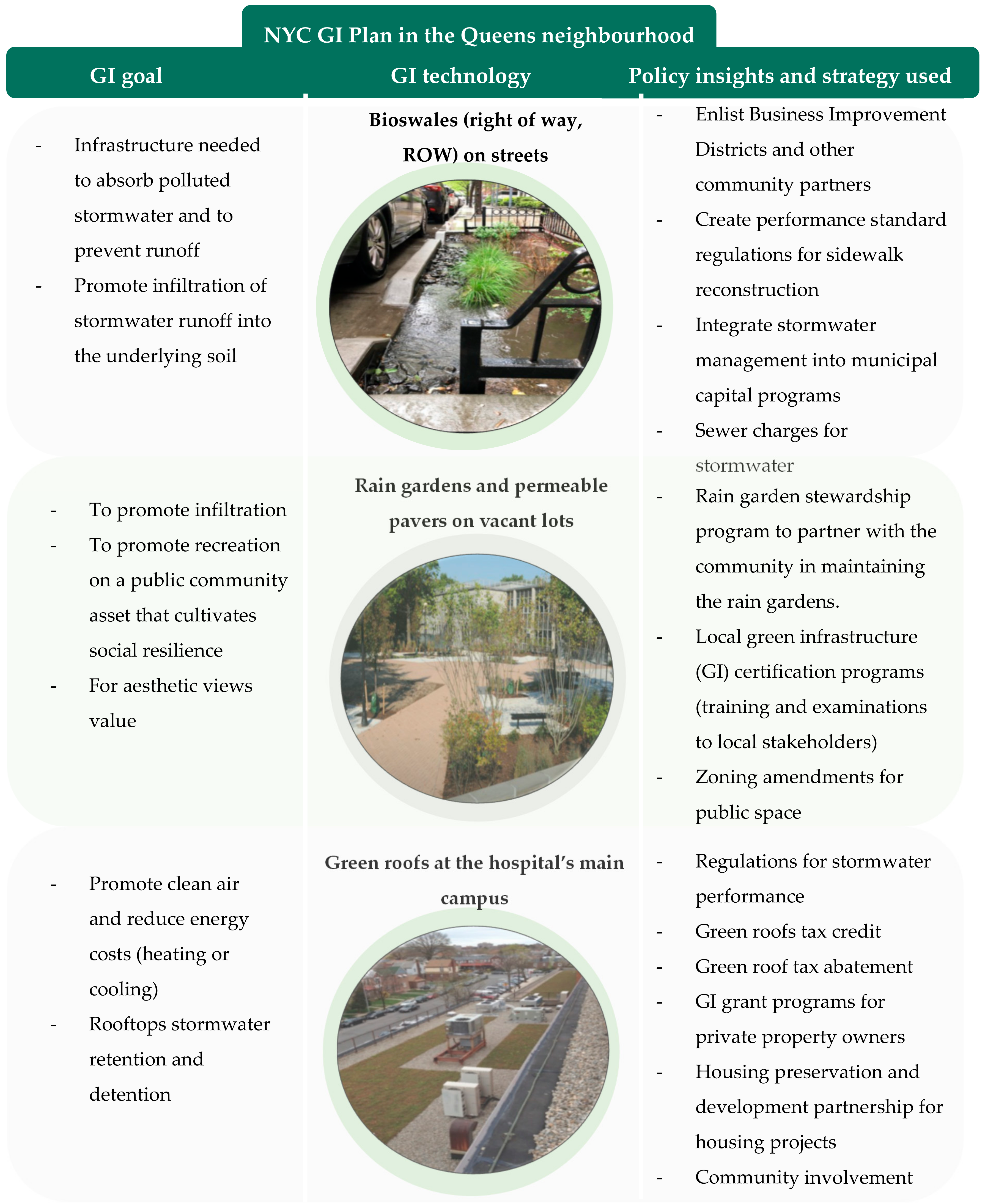
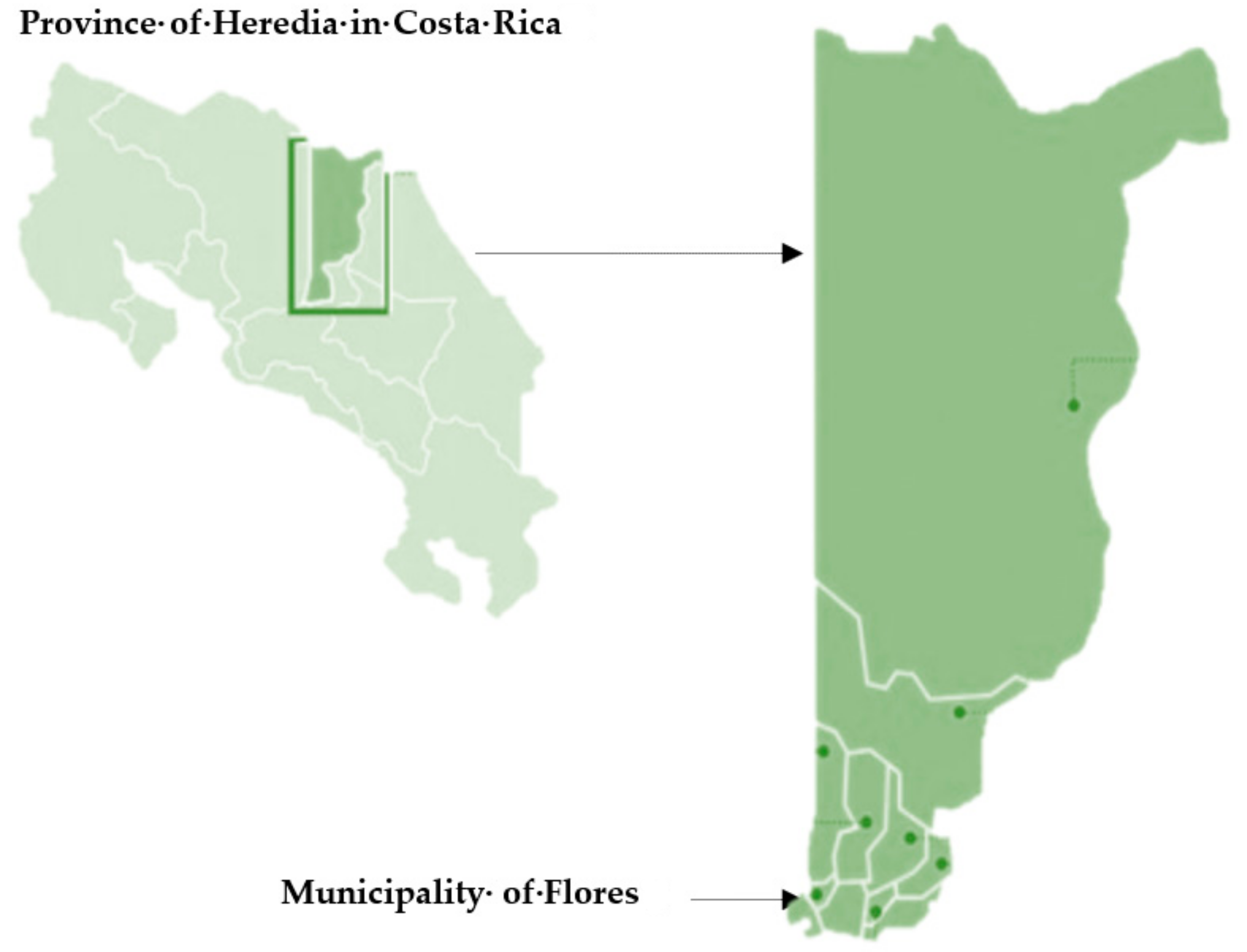
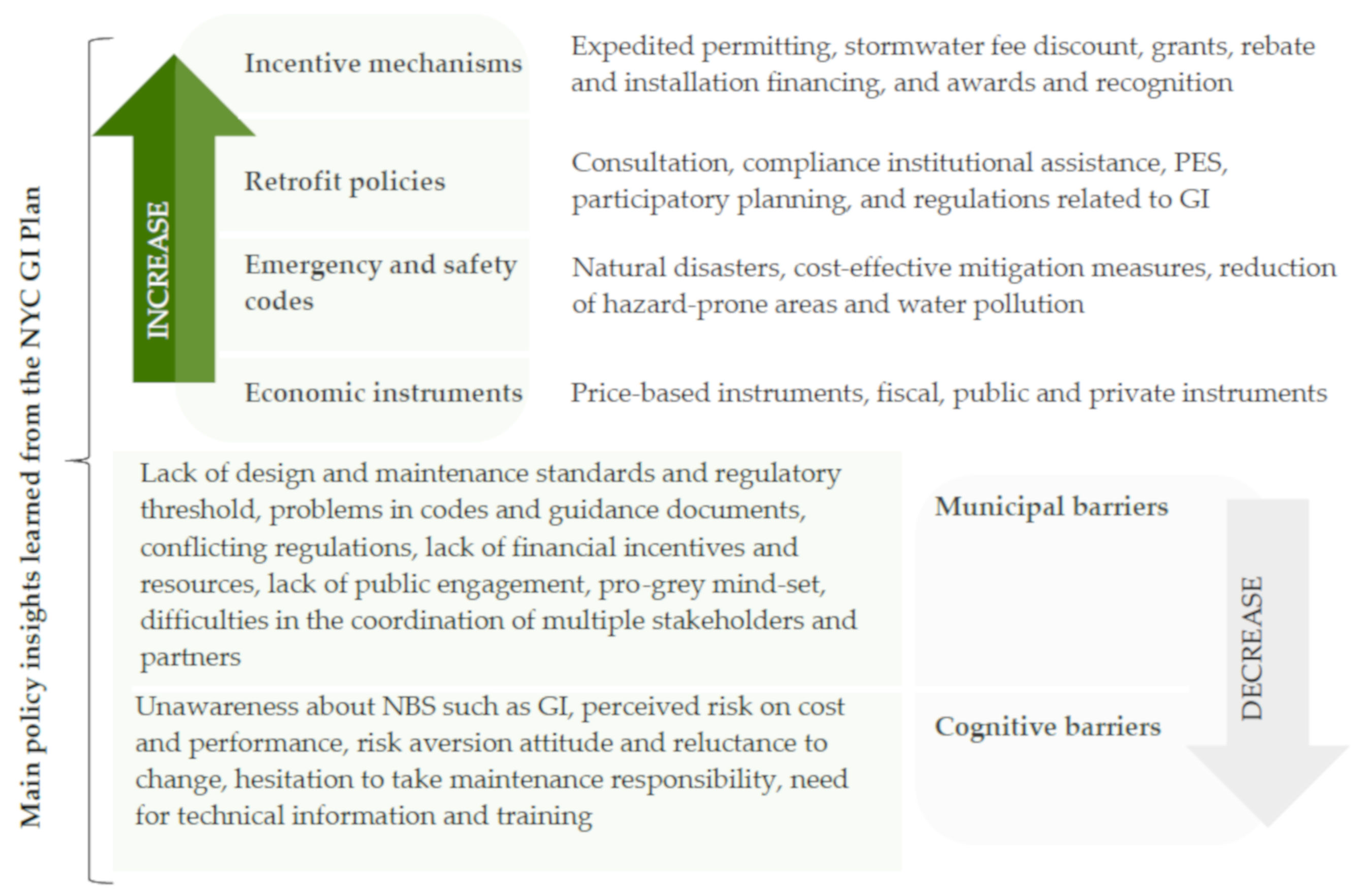
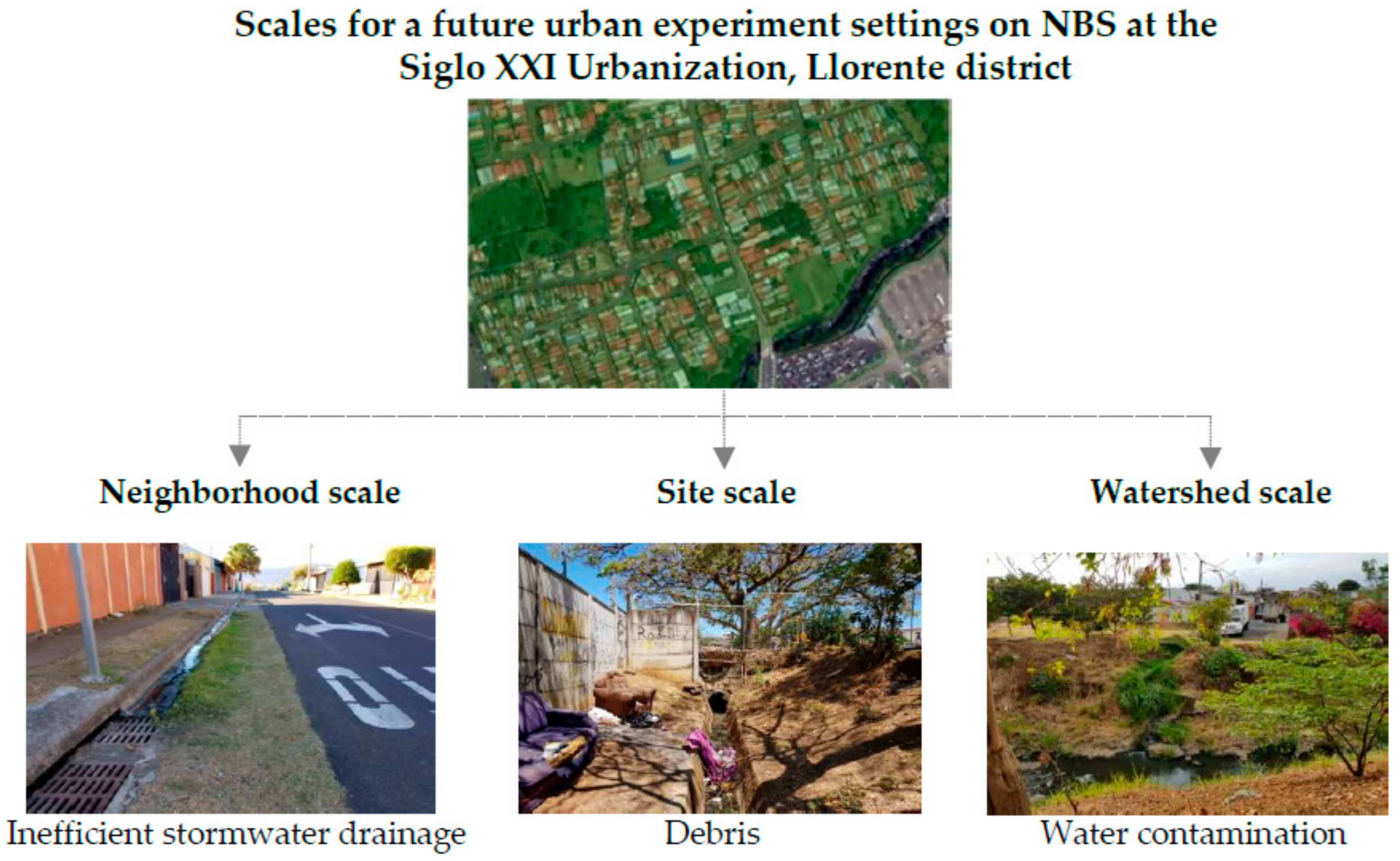
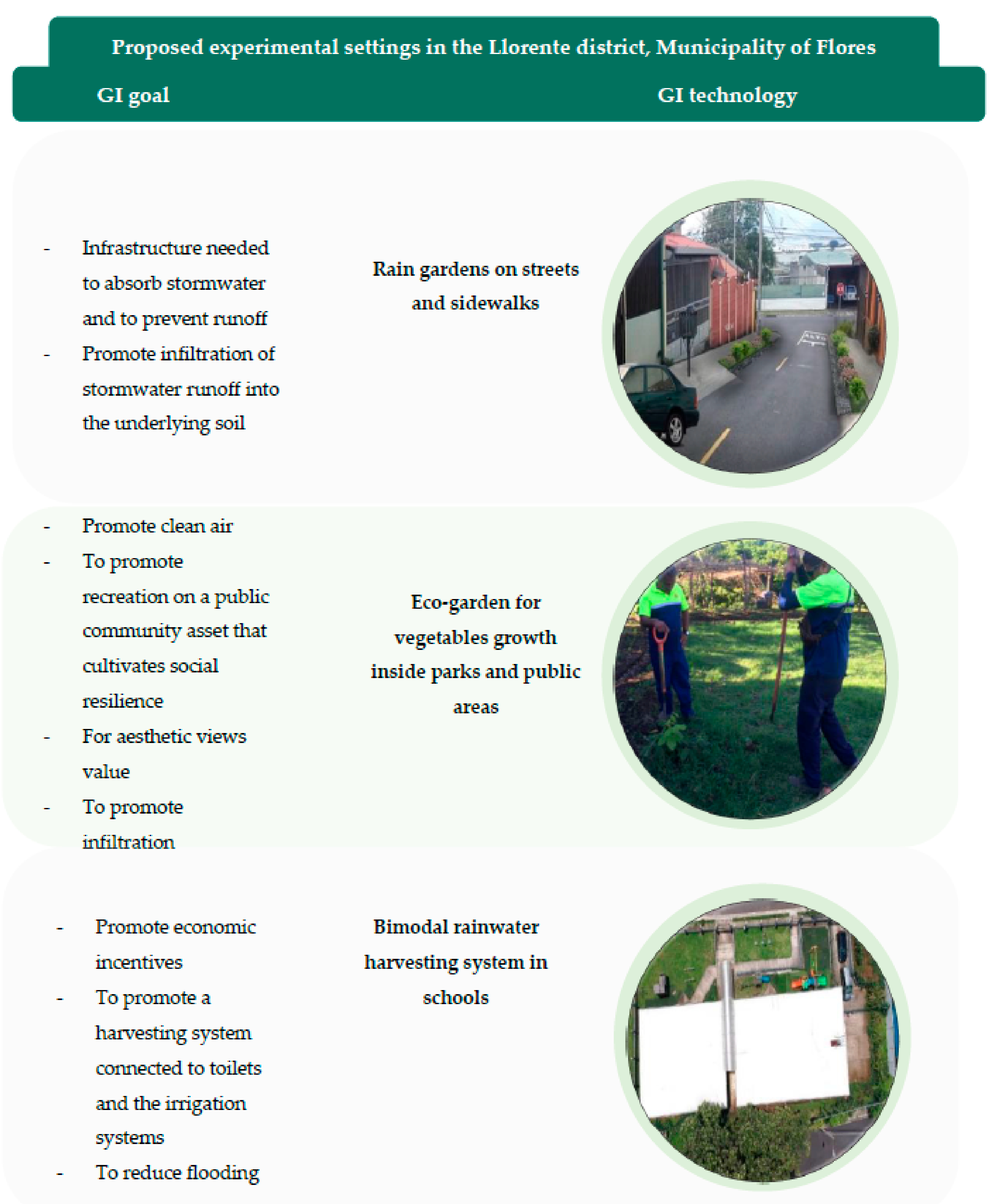
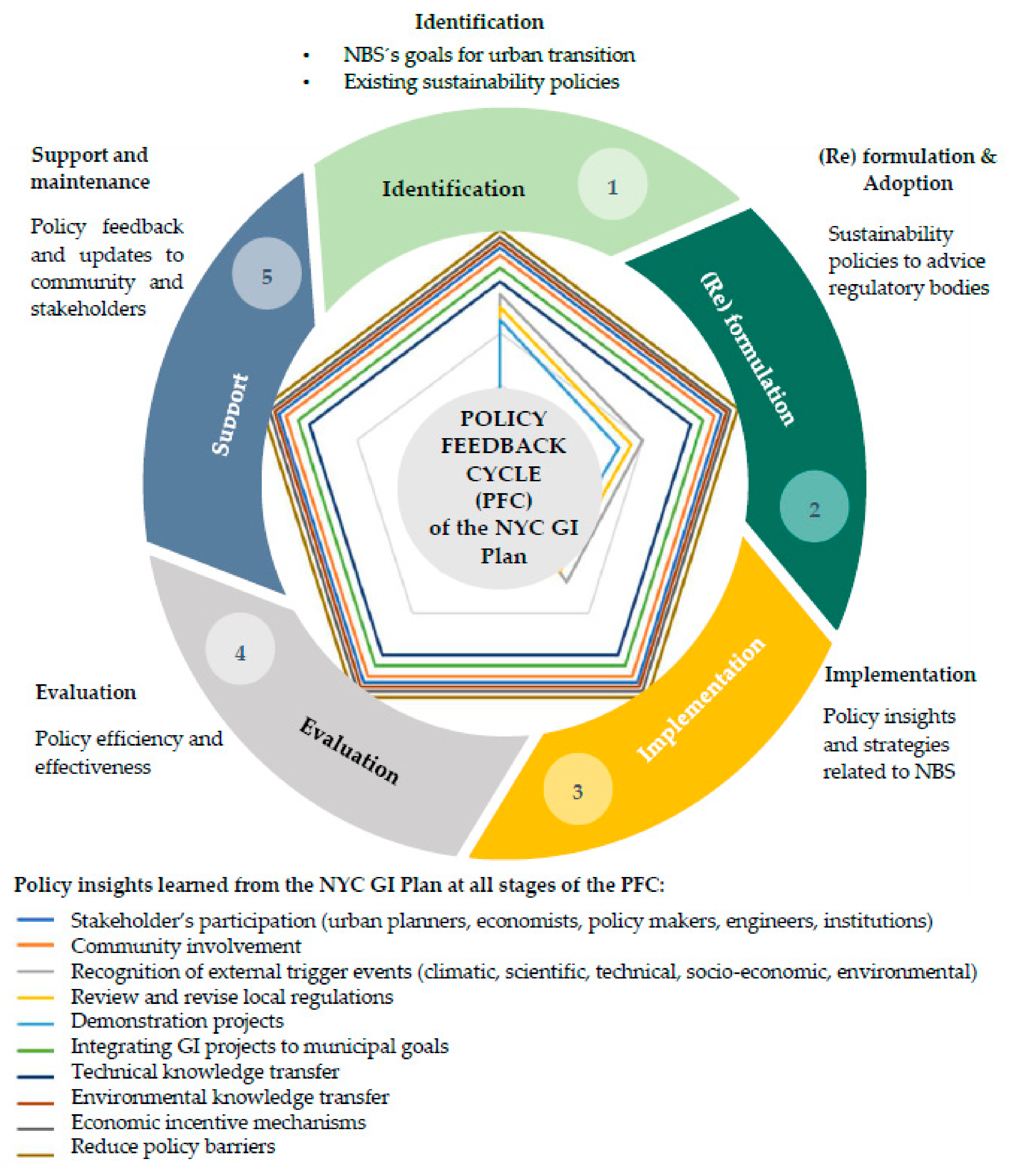
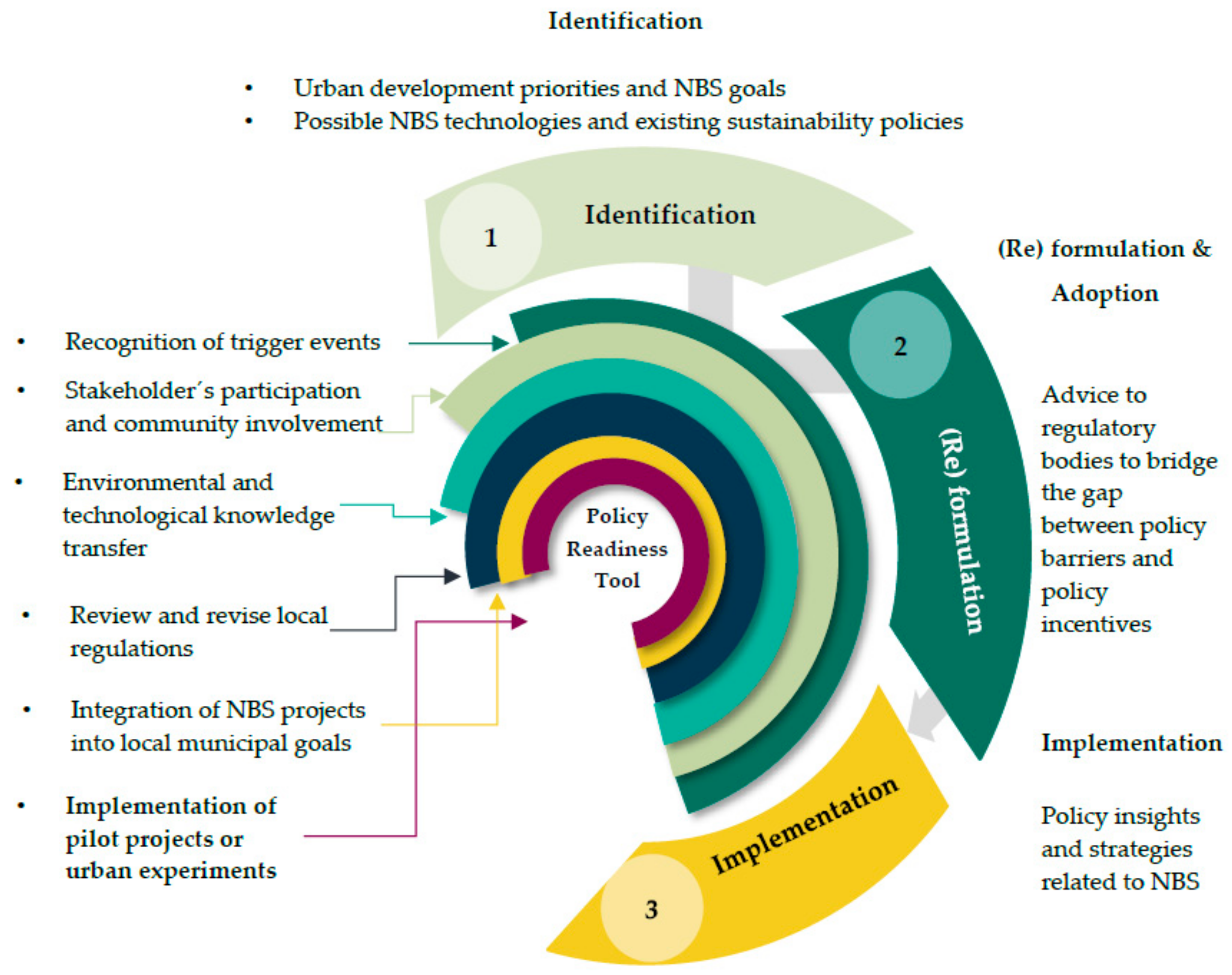
| Policy Stage | Definition |
|---|---|
|
|
|
|
|
|
|
|
|
|
| Policy Stage | Policy Insights | Policy Insights Assessment at the Neighborhood, Site and Watershed Scale |
|---|---|---|
| 1 Identification | Urban development priorities |
|
| GI goals |
| |
| GI technologies |
| |
| Sustainability policies |
| |
| First and second stages Additional Policy insights and strategies used by the NYC GI Plan | Recognition of external trigger events |
|
| Stakeholder’s participation and community involvement |
| |
| Environmental and technical knowledge transfer |
| |
| Review and revise local regulations to overcome policy barriers |
| |
| Integration of GI projects into municipal goals | ||
| Implementation of small-scale demonstration projects to highlight policy barriers and socio-economic incentives |
| |
| 2 (Re)formulation and adoption | Advice to regulatory bodies Bridging the gap between current and desired policy context that promote GI. Reduce policy barriers and increase economic incentives mechanisms through the application of sustainability policies from the EPA (United States Environmental Protection Agency) | Suggested municipal policies and incentives for an urban sustainability transition:
|
| Stage | Policy Insights | Policy Insights Assessment at the Different Scales; See Figure 4. | |
|---|---|---|---|
| First stage Identification | Urban development priorities | ✓ | Neighborhood scale:
|
| ✓ | Site scale:
| ||
| ✓ | Watershed scale:
| ||
| First stage Identification | NBS goals | ✓ | Neighborhood scale:
|
| ✓ | Site scale:
| ||
| ✓ | Watershed scale:
| ||
| Possible NBS technologies | ✓ | Neighborhood scale:
| |
| ✓ | Site scale:
| ||
| ✓ | Watershed scale:
| ||
| Sustainability policies | ✓ | Neighborhood, site and watershed scale:
| |
| First and second stages Additional policy insights and strategies used by the NYC GI Plan | Recognition of external trigger events | ✓ | Neighborhood, site and watershed scale:
|
| Stakeholder´s participation and community involvement | ✓ | Neighborhood, site and watershed scale:
| |
| ✕ | Neighborhood, site and watershed scale:
| ||
| Environmental and technical knowledge transfer | ✓ | Neighborhood, site and watershed scale:
| |
| ✕ | Neighborhood, site and watershed scale:
| ||
| Review and revise local regulations to overcome policy barriers | ✕ | Policy barriers at the neighborhood, site and watershed scale:
| |
| First and second stages Additional policy insights and strategies used by the NYC GI Plan | ✕ |
| |
| Integration of NBS projects into local municipal goals | ✕ | Neighborhood, site and watershed scale: | |
| Implementation of small-scale demonstration projects to highlight policy barriers and socio-economic incentives | ✓ | Neighborhood, site and watershed scale:
| |
| 2 (Re) formulation and adoption | Advice to regulatory bodies Reduce policy barriers and increase economic incentives This paper suggests to the Municipality of Flores the following policies and incentives for the implementation of NBS | ✓ | Neighborhood scale:
|
| ✓ | Site scale:
| ||
| Advice to regulatory bodies | ✓ | Watershed scale:
| |
© 2019 by the authors. Licensee MDPI, Basel, Switzerland. This article is an open access article distributed under the terms and conditions of the Creative Commons Attribution (CC BY) license (http://creativecommons.org/licenses/by/4.0/).
Share and Cite
Neumann, V.A.; Hack, J. A Methodology of Policy Assessment at the Municipal Level: Costa Rica´s Readiness for the Implementation of Nature-Based-Solutions for Urban Stormwater Management. Sustainability 2020, 12, 230. https://doi.org/10.3390/su12010230
Neumann VA, Hack J. A Methodology of Policy Assessment at the Municipal Level: Costa Rica´s Readiness for the Implementation of Nature-Based-Solutions for Urban Stormwater Management. Sustainability. 2020; 12(1):230. https://doi.org/10.3390/su12010230
Chicago/Turabian StyleNeumann, Veronica Alejandra, and Jochen Hack. 2020. "A Methodology of Policy Assessment at the Municipal Level: Costa Rica´s Readiness for the Implementation of Nature-Based-Solutions for Urban Stormwater Management" Sustainability 12, no. 1: 230. https://doi.org/10.3390/su12010230
APA StyleNeumann, V. A., & Hack, J. (2020). A Methodology of Policy Assessment at the Municipal Level: Costa Rica´s Readiness for the Implementation of Nature-Based-Solutions for Urban Stormwater Management. Sustainability, 12(1), 230. https://doi.org/10.3390/su12010230






